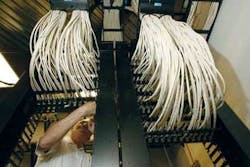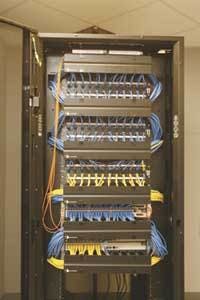The DeSoto County, Mississippi school district gets high marks for the services its cabling systems make possible.
Milton Kuykendall, superintendent of education for DeSoto County, Mississippi, has a clear vision for his school system: “This will be the best school system in the country.” It is a bold statement, but something in his demeanor makes everyone in the room believe it will happen.
Back behind his desk just hours after learning his leg is broken, he speaks passionately about the exponential growth of DeSoto County. “Every day, 7.5 families move to DeSoto, bringing more than 1,800 new students per year,” says Kuykendall, “and the biggest reason is the school system this team has built-the teachers, staff, and administrators have made something special here.”
The numbers reinforce that something special is happening. Of 26 schools in the county, 16 have received a “superior” rating according to the No Child Left Behind Act, and seven others are considered “exemplary.” In a state consistently rated near the bottom of most educational lists, DeSoto County is beating the odds.
A major part of the school system’s progress is tied to technology. “We are building a 21st-century school district,” Kuykendall explains. “We are combining curriculum and technology; we’re getting them to mesh seamlessly.”
The ongoing program to present technology as a critical learning tool is sweeping. The district’s list of computer and network-based educational applications include:
• Video classrooms;
• Voice over IP;
• Streaming digital curriculum;
• Web-based applications;
• E-mail;
• Student and faculty Internet access;
• Environmental controls;
• Closed-circuit television;
• Lab applications;
• Cafeteria point-of-service;
• Office administration applications;
• Library management;
• Intrusion-prevention systems.
Focus on cabling
While these applications provide DeSoto students and faculty outstanding and comprehensive access to e-learning resources, they add considerable strain to the network infrastructure. The responsibility of ensuring that the network is capable of handling increased performance requirements belongs to Lendon Balch, DeSoto’s director of technology delivery. From the earliest planning stages, Balch and Robert Earl Phillips, DeSoto’s director of physical plant, closely examined their physical infrastructure needs, focusing on the cabling system.
Their initial research and analysis narrowed the available options: DeSoto could continue to install Category 5e unshielded twisted-pair (UTP) cabling, as it had in previous school networks, or it could move to a 10-Gbit/sec-capable solution.
To Balch, the decision was clear. “I have been to seminars discussing everything from video to backup storage devices,” he explains. “They all discuss 10-Gbits/sec as if it were already the approved standard.” With the 10GBase-T standard nearing ratification, Balch had little difficulty showing other decision makers that 10-Gbits/sec was for real. But convincing people that an elementary school needs 10-Gbits/sec was another issue. Balch was prepared to answer this one as well. “I have learned over the years never to say things like, ‘We’ll never need that,’ or ‘I can’t see our district ever wanting to do that.’”
This understanding of network advances was supported by DeSoto’s own experiences. The district was already replacing Category 5 installations that were less than eight years old. While some of these replacements were necessary due to quality issues with product and installation, some also were driven by the Category 5 infrastructure’s inability to support many of the newer classroom applications involving video and audio.
“Our needs are becoming just as demanding as any corporate environment and, in many cases, we are probably more demanding than most,” Balch explains. “To continue with a generation of cabling that we are already replacing in some buildings seemed ridiculous to me.”
Investing in Category 6A
Balch and Phillips made a strong case, and the DeSoto County School System decided that a 10-Gbit/sec cabling system was indeed the best choice for the county’s students. Carefully weighing all available systems, DeSoto selected Siemon’s 10G 6A UTP end-to-end copper network cabling system for the horizontal. This Category 6A (Augmented Category 6) solution meets or exceeds all performance requirements dictated by the 10GBase-T standard, and met all of DeSoto’s needs for the data network. In addition, the district chose Siemon’s XGLO 10-Gbit/sec singlemode fiber for backbone data traffic.
With its cabling system selected, DeSoto put forth a competitive bid package. Based upon the preliminary network specifications, they sought a best-value installation provider. It was important that the installer be selected from Siemon’s network of certified installers because the company’s 20-year system warranty provides product, performance, and installation coverage.
Only Siemon-certified installers can provide installations eligible for the system warranty, and only installers who attend and pass the manufacturer’s five-day, ISO-9001-certified installation and network design class can become a certified installer. These organizations are heavily screened for stability and must maintain their certification through continuing education. “We know the value of a professional installation,” Balch explains, “because we know the issues caused by poor installation practices.”
Much of DeSoto’s existing network suffered from a combination of poor installation practices, inadequate planning, and poor quality of material. “We have patch panels that have developed dead ports, cable that has become brittle, and wall jacks that must be replaced on a regular basis,” Balch explains. “The performance of our networks has been degraded in some of our buildings to the point where we have no other choice than to tear it out and start over.” Balch and the rest of the DeSoto team strongly believed that a quality installation was as critical as the product itself.
After an exhaustive final selection process, DeSoto awarded the project to Cyber Technologies of Senatobia, MS based on the strength of the contractor’s best, lowest-cost bid. “By thetime DeSoto selected Cyber Technologies, they had a strong vision for their network and had chosen their cabling plant,” explains Hugh Brewer, president of Cyber Technologies. “We arrived just in time to design and implement the infrastructure.”
Emphasis on installation
Working closely with Balch and Phillips, Brewer designed an infrastructure to support the school’s immediate and future needs, with an eye toward simple moves, adds, and changes as well as centralized control and troubleshooting. The basic design would be repeated for all schools, modified as necessary to accommodate architectural concerns.
The new network data backbone consists of 12 strands of 50/125-µm Siemon XGLO multimode fiber and six strands of singlemode. In keeping with DeSoto’s future-looking approach, this 10-Gbits-capable backbone is well suited to support a growing network. Laid out in a star topology, the fiber data backbone is supplemented by two 50-pair Category 3 cables to handle all intercom and CCTV equipment, as well as one RG-11 for cable TV.
The horizontal infrastructure features Siemon’s 10G 6A UTP end-to-end cabling system for data, which includes cable, patch panels, patch cords, and work-area solutions, as well as racking and cable management. Although Brewer, Balch and Phillips all believed in the performance benefits of a Category 6A UTP solution, the prospect of working with the cable was a bit scary. “The diameters on all of the alien-crosstalk-compliant cables were pretty big and didn’t look very easy to work with,” Brewer says.
The increased cable diameters can be traced back to the extraordinary means employed by cable manufacturers to develop alien-crosstalk-compliant UTP cable. Telecommunications Industry Association (TIA) standards allow increased Category 6A cable diameters of up to 0.354 inches (9 mm), compared to Category 6 at 0.22 inches (5.64 mm). While the ability to control alien crosstalk in a familiar UTP construction was a benefit for DeSoto and Cyber Technologies, the increased cable size significantly decreased pathway cable counts and density.
“Luckily, we had time to plan additional pathway space to accommodate the thicker cable,” Brewer explains. “And density at the patch panel was a pleasant surprise.” Brewer attributes the unexpected density to the fact that the patch panels’ increased port spacing, designed to optimize alien crosstalk performance, also eliminates the need for rack-mounted horizontal cable managers. Cyber Technologies installers were able to route patch cords directly into vertical managers, saving two to three rack-mount spaces per patch panel.
Brewer was also pleasantly surprised at the ease with which the Category 6A cable could be pulled. “It was some of the easiest cable I’ve pulled, of any category,” he says. “The jacket slid easily, even in large bundles, and it came off the reel with no memory-no kinks, no bends.” Brewer and his team also saw little difference in termination, and suggested that the 23-AWG conductors added a benefit over smaller gauge wires. “The thicker conductors were stiffer and took a little more effort to untwist for termination, but once they were laid out, they stayed where they were supposed to.”
Brewer admits that he and his team had to learn new installation techniques: “All of these Category 6A UTP cables may offer good alien-crosstalk protection, but you have to be very cautious in your installation. You have to avoid anything that will deform the jacket.”
Deformation can be a threat to all Category 6A UTP cables, which use increased overall diameters to increase cable-to-cable pair separation for alien-crosstalk mitigation. Deforming the jacket decreases these separations and makes the cables susceptible to crosstalk.
Techniques Cyber Technologies uses to steer clear of this potential issue include avoiding over-cinched tie-wraps, staying within maximum pathway fill ratios, and carefully observing bend-radius limits.
Manageable design
In addition to the Category 6A data channels, the horizontal includes Category 5e for CCTV and RG-6 for cable TV. All horizontal channels are home run, going directly from the telecommunications room’s horizontal cross-connects to the work area. Brewer felt that this configuration would be the easiest for the school to manage. “We tend to think of a classroom as pretty static,” Brewer explains. “Sure, there may not be as many moves and changes as an office cubicle environment, but evolving education applications will absolutely require flexibility in the cabling plant. That flexibility is even more critical in the computer labs. The home-run configuration will make it far easier and less expensive for the school system to manage change on their own.”
The potential complexity of the network will make ease of management critical for DeSoto. The initial project includes seven schools in the county, ranging from 100,000 to 350,000 square feet. Each classroom is supplied with four drops, supporting the teacher workstation, network printer, VoIP phone, and video services. Computer lab areas receive 36 drops, all supporting workstations and printers. The initial phase of the project totaled more than 3,000 ports, each ready for 10 Gbits/sec. New schools and retrofits are on the way, and DeSoto’s Balch and Phillips intend to stick with their plan.
Back in superintendent Milton Kuykendall’s office, one has to be impressed with his commitment to DeSoto County’s students. Not many elected officials would be so willing to meet public criticism and cost-cutting pressures with a state-of-the-art network. Kuykendall seems unwilling to take much credit. “Lendon [Balch] and Robert Earl [Phillips] did their homework and told me that this cabling would support all of our technology initiatives for years to come,” he explains. “Not only will it make our students better, it will save us money in the long run. It will still be serving DeSoto when this office has someone else’s name on the door and I’m golfing full-time.”
As he finishes speaking, someone jokes that with all this effort, he might actually be serious about making DeSoto the best school system in the country. Kuykendall takes his broken and heavily braced leg down from his desk, leans over and says, “What makes you think I wasn’t serious before?”BRIAN DUVAL is director of communications for The Siemon Co. (www.siemon.com).


